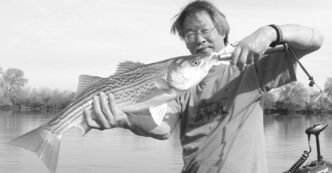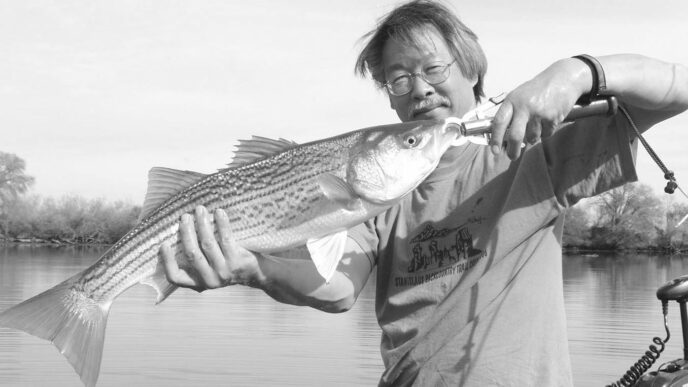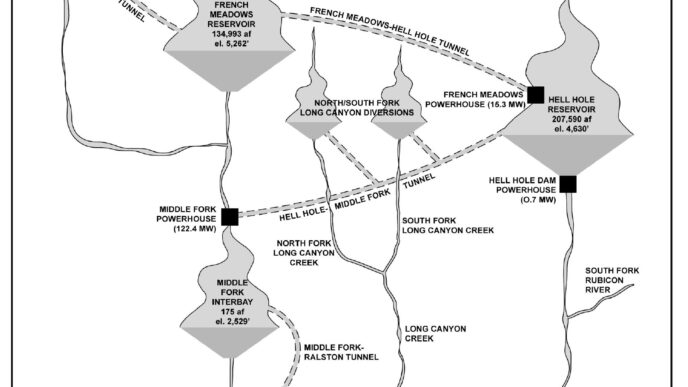Who’s got the vision for California’s fish and game?
More than 130 people with a stake in the future of wildlife think they do. That’s how many applied to serve on the State of California’s recently created Stakeholder Advisory Group, a citizens’ panel that will participate in an ambitious process to create a strategic vision for the state’s two main wildlife agencies, the California Department Fish and Game (DFG) and its policy-setting partner, the California Fish and Game Commission (FGC).
“We had no idea how many we were going to get applying,” said Clark Blanchard, spokesman for the California Natural Resources Agency, which oversees the DFG and FGC, and which is spearheading the planning effort. “We were surprised.”
The agency’s staff may have been surprised because the request for participants in the strategic vision process did not extensively describe the work, the long-term goal of which is to “improve and enhance the Department of Fish and Game’s capacity and effectiveness in fulfilling its public trust responsibilities for the protection and management of the state’s fish and wildlife, for their ecological values, and for the benefit of the people of the state.” The process and decision-making structure were defined in Assembly Bill 2376, which was introduced last year by a conservation-minded fly fisherman, Assembly Member Jared Huffman, D-San Rafael, approved by the state legislature, and signed into law by Governor Arnold Schwarzenegger.
The relatively large number of applicants to take part as stakeholders could be the result of many getting fired up by the rhetoric at legislative hearings on Huffman’s bill. “The Department [of Fish and Game] is dysfunctional,” Huffman told the press last year as his bill was winding through the legislature. “It’s a mile wide and an inch deep and is structured in a way that makes it vulnerable to political influences.” He also noted that the DFG is “chronically underfunded,” which hampers its ability to carry out its missions.
Because of the broad mission of the DFG and FGC, a cottage industry of advocacy groups has grown up to work on various issues in recent years. Many maintain offices in Sacramento, and their professional staff members are regulars at fish-and-game hearings in the legislature and before the FGC. A number of the applicants may have also participated in five previous fish-and-game strategic planning efforts. The DFG’s most recent plan was updated in 2006, and the FGC’s was adopted in 1998.
During the hearings on AB-2376, Huffman said he wanted the effort to be a positive review of the agencies. “I’m not doing this as a ‘beat up Fish and Game’ exercise,” he said at the time. “I am doing this because I care about Fish and Game. In order to make improvements, we need to shine some light on their failures.”
As defined in his bill, this “vision” process was modeled after one used to create a long-range plan for the Sacramento–San Joaquin Delta. The fish-and-game version for strategic planning will be created by three committees. (For more details on the committees, see the sidebar or the project Web site at http://www.vision.ca.gov.) The first is the seven-member Executive Committee, which is made up of cabinet-level state employees and representatives of federal agencies. It provides a high-level link to the governor’s office, the federal government, and the scientific community.
The second is a seven-member Blue Ribbon Citizen Commission, which is made up of three former members of the state legislature, two directors of agencies working in state policy issues, and two scientists. It will prioritize the policy recommendations and likely draft the final report. The third is the 54-member Stakeholder Advisory Group, organized to represent 17 areas of fish-and-game work. It will make recommendations on a wide range of issues, from government organization to funding.
The vision process started on June 28 with the executive committee selecting members, setting meeting schedules, and establishing operating rules. Under the enabling legislation, the planning process is to be completed by July 1, 2012, but Resources Agency officials said they would like to see work finished by January or February 2012, so implementing bills could be introduced in the new session of the state legislature.
These groups of visionaries will quickly discover that many of the problems of the fish-and-game agencies result from the large and growing number of regulatory issues with which they must deal, while funding has not kept pace to hire necessary staff to do the work.
California’s fish-and-game agencies have greatly expanded since being created in 1870 to increase and restore the state’s fish populations. In 1878, their authority was expanded to include game. The first hunting licenses were issued in 1907, when there was a warden force of 73. In 1939, wildlife-disease personnel were added, and in 1957, the marine region was created. Project review work greatly expanded when new acts were passed — the California Environmental Quality Act in 1970, the California Endangered Species Act in 1984, and the Natural Communities Conservation Protection Act in 1991. In recent years, the DFG and the FGC have undertaken a massive job of planning for the protection of marine life in the Pacific Ocean under the Marine Life Protection Act, which was passed in 1999 to create plans and regulations for protecting marine life in five regions. The DFG’s marine planning effort was criticized by some ocean fishery groups when the department used funds from the environmentally oriented David and Lucile Packard Foundation to pay for staff members to conduct research and write the plans and regulations. Today, the DFG has adopted regulations for two of the five MLPA marine regions. The 2011–12 budget allocates $4.4 million from the state’s General Fund to complete the job. DFG executives told the state legislature that the cost of fully implementing the marine program would range from $24 to $48 million annually.
In addition to the marine work, the DFG workload calls for writing plans for protecting salmon, steelhead trout, and other anadromous fisheries, completing wild-trout management plans, preventing oil spills through its sister agency, the Office of Oil Spill Prevention and Response, and analyzing the impact of fast-growing work related to renewable energy projects in order to meet the state’s climate-change goals.
As a result of the work of another sister agency, the Wildlife Conservation Board, the DFG owns and manages over a million acres of habitat land. The California Department of Parks and Recreation is the only state agency owning more property. “The lands in our portfolio outstrip our ability to manage them,” Kevin Hunting, the DFG’s chief deputy director, told members of the vision project’s Blue Ribbon Citizen Commission at a July 21 kickoff public hearing on the vision process. Department of Fish and Game executives told commission members that a strategic vision would have to deal with issues relating to tribal governments’ sovereignty over natural resources, animal rights groups challenging the ethics of hunting and fishing, increasing human and wildlife interactions, particularly in urban areas, water issues and invasive species, youth becoming disconnected from wildlife, conflicts between property rights, economics, and wildlife resources, more common and expensive litigation, and the challenges of enforcing fish-and-game laws on 159,000 square miles of land with 392 sworn officers, including field wardens and managers. Each warden now patrols some 600 square miles.
At the kickoff hearing, a spokeswoman for Assembly Member Huffman, who was traveling at the time, said the DFG is falling behind in achieving its mission. “So much of California’s incredible natural resources are threatened or at risk of being lost,” said Tina Cannon Leahy, a member of Huffman’s legislative staff. “Today’s DFG has a much broader and more vital mission than it did 100, 50 or even 10 years ago. The DFG is failing to excel or even to achieve modest success in most aspects of its mission today, and without major changes, this will only worsen in the years ahead. The department is too critical to fail. A fundamental reset — not fine tuning — is needed.”
At the hearing, DFG finance executives used complex charts and graphs to attempt to explain the funding sources that make up the department’s annual budget. The DFG’s budget has grown from about $150 million in 1994–95 to a high of nearly $450 million in 2010–11. The 2011–12 budget is $386 million. The DFG spends about one quarter of its revenue on hunting, fishing, and public-use issues, while other spending categories include managing lands, its Biodiversity Conservation Program, and oil spill prevention and enforcement, which accounts for about 12 percent or $45 million of the budget. Only 14 percent of the DFG’s revenue comes from the state’s General Fund. The rest is generated by a Byzantine structure of state, federal, and local agency revenue, bonds, and over 300 dedicated fees that pay its 2,000 employees who work in six inland and one marine region.
As part of the strategic vision process, the DFG will create a Sustainable Financing Working Group to make recommendations on how to improve the complex funding. Members of that group, who have not yet been appointed, will not only have to understand public-agency financing, but also be able to figure out ways to generate additional public and private funds in a sour economic climate. Past DFG planning efforts have explored increasing the state sales tax, instituting a real estate transfer tax, charging fees for visiting wildlife areas, and other ways of raising funds for the department. Most of those efforts never got off the ground or were killed by the state legislature.
Since the strategic-vision process has just started, few priorities for a revamped DFG have emerged. Based on previous planning efforts, here are some policy issues that could be discussed.
Name Change. Should the name of the California Department of Fish and Game be changed to the California Department of Fish and Wildlife to reflect a broader orientation toward dealing with wildlife, rather the more traditional fishing and hunting issues? Previous groups have discussed renaming the agency, but a lack of leadership from the department, from advocates, and from lawmakers has kept any name change from being made.
Narrow the DFG’s Focus. Conversely, should the DFG return to its earlier role of just dealing with rules, regulations, and issues related only to fishing and hunting? This question is often asked at the agency, legislative, and gubernatorial levels, especially when appointing a new DFG director. Such a major change would likely be fought by stakeholders interested in broader environmental concerns like habitat protection, wildlife preservation, biology, scientific research, and other so-called “nongame” issues.
DFG Director. Should the method of appointing the DFG director be changed? Nearly every planning effort has discussed taking the job of appointing the DFG director away from the governor. These efforts usually die because they can’t get through the state legislature or can’t avoid getting vetoed by a governor who doesn’t want to relinquish control of the appointment. Others have discussed requiring that the DFG director have a background in wildlife management or a related professional expertise.
Fish and Game Commissioners. Previous planners have discussed adding more positions to the five-member California Fish and Game Commission and depoliticizing the commission by requiring that commissioners have professional credentials in wildlife or technical areas.
County Commissions. Previous planners have discussed how to give county fish-and-game commissions a more relevant role in funding wildlife projects or helping the DFG and the FGC set policies. Currently, the main role of the commissions is to spend part of the funds collected from fish-and-game violations.
Game Wardens. Following a DFG study a number of years ago, fish-and-game insiders discussed merging the warden force with the California State Police, whose officers earn more pay than wardens. Any such change has not been able to gain support from the warden’s union, which is the same union representing rangers at California’s state parks.
Plan Implementation. Many planning efforts result in reports that never leave the bookshelf, because no group or coalition champions their implementation. Public agency directors and executives, often career civil servants, are rarely agents of change, and the state legislature hasn’t had a good record for making complex changes involving agency operations. Successful change usually relies on stakeholder groups to keep pushing politicians and bureaucrats to implement the adopted plans long after the public planning sessions are ended.
The Planning Process
Nearly 70 people organized into committees and groups are expected to take part in the latest process for creating a strategic vision for the state’s fish and game agencies. Here’s how the process will work.
The Legislative Mandate
Assembly Bill 2376, introduced in the last legislative session by Assembly Member Jared Huffman, D-Santa Rosa, calls for creating a strategic vision for fish and wildlife. The vision is to be created for the California Department of Fish and Game and the Fish and Game Commission. All meetings are open to the public, and the results of the work will be available on a Web site.
Organizational Structure
Work to create the vision will be done by the following committees:
The Executive Committee is made up of cabinet-level state employees and federal agencies. Members include John Laird, secretary of the California Natural Resources Agency; John McCamman, acting director of the California Department of Fish and Game; Jim Kellogg, president of the California Fish and Game Commission; Robert Weisenmiller, chair of the California Energy Commission; Daniel Dooley, vice president of the University of California Division of Agriculture and Natural Resources; Ron Lohoefener, regional director for the Pacific Southwest Region of the U.S. Fish and Wildlife Service; and Rodney McInnis, regional administrator of the National Marine Fisheries Service.
The Blue Ribbon Citizen Commission is made up of three former members of the state legislature and two directors of agencies working on state policy issues: Dennis Hollingsworth, a former Southern California legislator and now a member of the Unemployment Insurance Appeals Board; Pedro Nava, a former legislator from Southern California; Mary Salas, a former legislator representing the San Diego area; Richard Frank, director of the California Environmental Law and Policy Center at the University of California, Davis; David Graber, chief scientist for the Pacific West Region of the National Park Service; Skyli McAfee, executive director of California Oceans Trust; and Anne Sheehan, director of corporate governance at the California State Teachers’ Retirement System (CalSTRS).
The Stakeholder Advisory Group consists of 53 members representing 17 groups focused on fish-and-game issues. Of the total, only one group and its members focus on recreational angling issues. This Sport Fishing Group is consists of Chuck Bonham, an attorney for Trout Unlimited (he has also recently been appointed by Governor Brown to serve as the new director of the Department of Fish and Game); Robert Gallia of the Golden Gate Fisherman’s Association; and April Wakeman of The Sportfishing Conservancy, a group oriented toward bait anglers.
Other groups within the Stakeholder Advisory Group will focus on issues related to hunting, nonprofit conservation organizations, nonconsumptive recreational uses, landowners, science and education, agriculture, business and industry, tribal/environmental justice, labor, marine resources, water, local government, state government, federal government, and the ever-popular category of “other” issues, which contains individuals involved with endangered species, oyster farming, and land-trusts.
The Timetable
The vision process started in mid-June with officials selecting committee members and setting meeting schedules. Under the enabling legislation, the process is to be completed by July 1, 2012, but Resources Agency officials said they would like to have all work finished by January or February of 2012, so that implementing bills can be introduced in the new session of the state legislature.
More Information
The following information is available on the Fish and Wildlife Strategic Vision section of the DFG website at http://www.vision.ca.gov: a complete list of all members of the Stakeholder Advisory Group; a complete schedule of dates, locations, and results of meetings of the committees; and various reports on current and previous strategic-planning efforts.
Tom Martens















